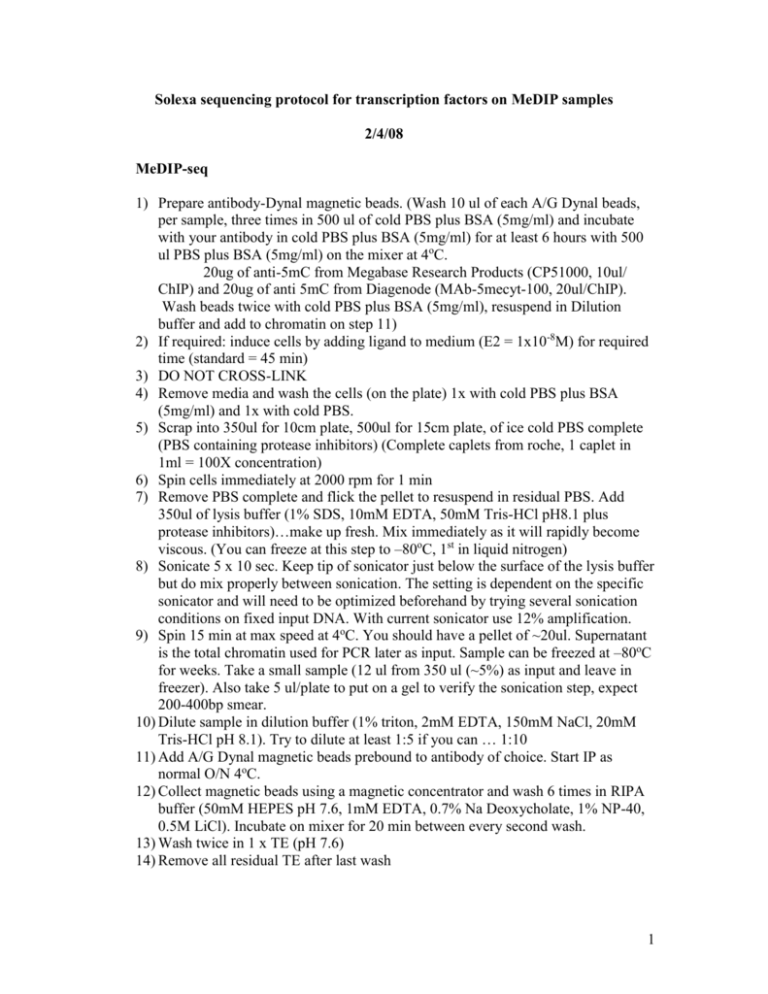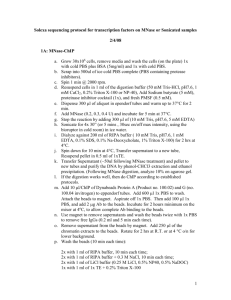Protocol for Solexa sequencing analysis
advertisement

Solexa sequencing protocol for transcription factors on MeDIP samples 2/4/08 MeDIP-seq 1) Prepare antibody-Dynal magnetic beads. (Wash 10 ul of each A/G Dynal beads, per sample, three times in 500 ul of cold PBS plus BSA (5mg/ml) and incubate with your antibody in cold PBS plus BSA (5mg/ml) for at least 6 hours with 500 ul PBS plus BSA (5mg/ml) on the mixer at 4oC. 20ug of anti-5mC from Megabase Research Products (CP51000, 10ul/ ChIP) and 20ug of anti 5mC from Diagenode (MAb-5mecyt-100, 20ul/ChIP). Wash beads twice with cold PBS plus BSA (5mg/ml), resuspend in Dilution buffer and add to chromatin on step 11) 2) If required: induce cells by adding ligand to medium (E2 = 1x10-8M) for required time (standard = 45 min) 3) DO NOT CROSS-LINK 4) Remove media and wash the cells (on the plate) 1x with cold PBS plus BSA (5mg/ml) and 1x with cold PBS. 5) Scrap into 350ul for 10cm plate, 500ul for 15cm plate, of ice cold PBS complete (PBS containing protease inhibitors) (Complete caplets from roche, 1 caplet in 1ml = 100X concentration) 6) Spin cells immediately at 2000 rpm for 1 min 7) Remove PBS complete and flick the pellet to resuspend in residual PBS. Add 350ul of lysis buffer (1% SDS, 10mM EDTA, 50mM Tris-HCl pH8.1 plus protease inhibitors)…make up fresh. Mix immediately as it will rapidly become viscous. (You can freeze at this step to –80oC, 1st in liquid nitrogen) 8) Sonicate 5 x 10 sec. Keep tip of sonicator just below the surface of the lysis buffer but do mix properly between sonication. The setting is dependent on the specific sonicator and will need to be optimized beforehand by trying several sonication conditions on fixed input DNA. With current sonicator use 12% amplification. 9) Spin 15 min at max speed at 4oC. You should have a pellet of ~20ul. Supernatant is the total chromatin used for PCR later as input. Sample can be freezed at –80oC for weeks. Take a small sample (12 ul from 350 ul (~5%) as input and leave in freezer). Also take 5 ul/plate to put on a gel to verify the sonication step, expect 200-400bp smear. 10) Dilute sample in dilution buffer (1% triton, 2mM EDTA, 150mM NaCl, 20mM Tris-HCl pH 8.1). Try to dilute at least 1:5 if you can … 1:10 11) Add A/G Dynal magnetic beads prebound to antibody of choice. Start IP as normal O/N 4oC. 12) Collect magnetic beads using a magnetic concentrator and wash 6 times in RIPA buffer (50mM HEPES pH 7.6, 1mM EDTA, 0.7% Na Deoxycholate, 1% NP-40, 0.5M LiCl). Incubate on mixer for 20 min between every second wash. 13) Wash twice in 1 x TE (pH 7.6) 14) Remove all residual TE after last wash 1 15) Add 100ul of 1% SDS and 0.1M NaHCO3. Due the same to Input samples. Vortex beads in this solution every few minutes for 30 min total. While at 65oC O/N to reverse cross-linking. Minimum of 6 hours reverse, but a maximum of 1416 hours. 16) Purify with QIAquick spin kit (PCR purification kit)- add 500 ul PB, vortex, collect beads, transfer supernatant to column, spin add 500 ul PE, spin, 500 ul PE, spin, spin, collect in 50 ul EB buffer for IP and 100 ul for Input. Spin, Add 75 ul to IP tubes and 150 ul to Input tubes. Quantify using picogreen 17) Use 5ul for real-time PCR (You may be able to dilute this sample depending on your ChIPing efficiency. If it does not work at these concentration change Abs). 5 ul DNA 4 ul H2O 1 ul Primers (5uM each) 10 ul 2X SYBR If the enrichment is weak try meDIP on ssDNA (boil samples for 10 min before step 10). This will force you to do a random primer amplification before starting the library prep for solexa in order to have dsDNA using Sigma WGA kit. LIBRARY PREPARATION FOR SINGLE END SEQUENCING (Illumina) 1. Repair DNA ends using the Epicentre DNA END-Repair kit (Cat. No. ER0720, Epicentre Biotechnologies, Tel 800-284-8474) This step generates blunt-ended DNA. 1-34 ml DNA (0.1 to 5 mg) 5 ml 10x End repair buffer (330 mM Tris-acetate, pH7.8, 660 mM potassium acetate, 100 mM magnesium acetate, 5 mM DTT) 5 ml 2.5 mM each dNTPs 5 ml 10 mM ATP x ml H2O to adjust the reaction volume to 49 ml 1 ml End-Repair Enzyme mix (T4 DNA Pol + T4 PNK) Incubate 45 min at room temperature. Purify the DNA by Phenol-CHCl3 extraction. Resuspend the DNA in 30 ml of 1xTE. 2. Add “A” to 3’ ends 30 ml DNA from above 2 ml H2O 5 ml 10x Taq buffer 10 ml 1 mM dATP 3 ml 5 U/ ml Taq DNA polymerase 2 Incubate for 30 min at 70°C. Purify the DNA as before. Resuspend pellet in 10 ml of 1x TE. 3. Linker ligation (two mixed linkers). The oligo mix should contain 10x molar excess of the DNA templates. 2X NEB quick ligase buffer Annealed linkers (5 uM) – see below Quick DNA ligase (NEB) DNA sample Total volume 10.0 ul 1.0 ul (IS THIS ENOUGH?) 1.0 ul 9.0 ul 21.0 ul Incubate for 30 min at room temperature. Ethanol precipitate. Resuspend in 10 ul. Annealed linker Oligo Forward: GATCGGAAGAGCTCGTATGCCGTCTTCTGCTTG (HPLC purified) Oligo Reverse: ACACTCTTTCCCTACACGACGCTCTTCCGATCT (HPLC purified) - Combine 750 ul Tris-HCl (1M) pH 7.9 125 ul oligo Forward (40 uM stock) 125 ul oligo Reverse (40 uM stock) - Heat at 95oC for 5 min, then immediately into 70oC heat block (holes filled with water) and remove heat block and leave in the cold room to slowly cool. Make aliquots in the cold room and freeze. 4. Size selection-2% - Add 3ul to ligated DNA, run on a 2% Nu-Sieve Agarose gel. - Run 120 V 1hr. Cut band in the 200 + 25 bp range. Although you may not be able to see a band, the DNA is there but in very small amounts. - Elute with Gel extraction kit, resuspend in 30 ul buffer EB. 5. Amplify the DNA using Solexa primers and enzyme mix (Run a 25 ml reaction). 10.5 ml of DNA 12.5 ml of master mix 3 1 ml of PCR primer 1.1 (5uM) (AATGATACGGCGACCACCGAGATCTACACTCTTTCCCTACACGACGCTCTTCCGATCT) 1 ml of PCR primer 2.1 (5uM) (CAAGCAGAAGACGGCATACGAGCTCTTCCGATCT) Total volume: 25 ml Denature at 98°C for 30 sec. 98°C, 10”; 65°C, 30”; 72°C, 30”. Try 18 cycles first, check 2.5 ml of product on 1.8% gel. If the band is not clearly visible, do 3 more cycles. Check again. Purify the amplified products on 2.5% agarose gel. Excise the band near 220 bp and purify the DNA using Qiagen gel extraction kit. Use the regular gel extraction kit as opposed to the MinElute in order to wash the membrane with a higher volume. Heat the EB to 55 Celsius first. YOU MUST DO THE OPTIONAL STEPS, AS IT DOES AFFECT YIELD. Measure the DNA concentration using picogreen or nanodrop. You may also verify the size quality of your sample using the bioanalyser. 4







